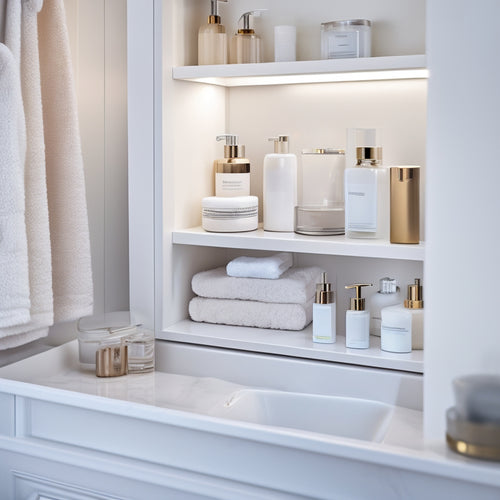
Building a Shelf Around a Pedestal Sink Tutorial
Share
You'll start by gathering lumber, essential tools, and aesthetic finish options, ensuring your materials provide sturdiness and visual appeal. Next, measure the pedestal sink area, recording height, width, and depth, while identifying obstacles and verifying alignment. Design your shelf layout based on precise measurements, choosing materials that fit your desired style. Then, cut your shelf boards, assemble the frame, and attach it to the wall. Install the shelf boards, add decorative trim work, and finish with a stability check and inspection. Now, you're ready to bring your design to life - and with a few more critical steps, you'll have a beautiful, functional shelf around your pedestal sink.
Key Takeaways
- Measure the pedestal sink area accurately, accounting for trim, molding, and plumbing access points to ensure a seamless fit.
- Design the shelf layout based on precise sink measurements, choosing materials that balance durability and aesthetics.
- Select shelf materials that can withstand bathroom humidity, such as wood or glass, and consider durability and environmental factors.
- Assemble the shelf frame using wood glue and screws, ensuring a solid and functional structure that can hold the desired weight.
- Attach the shelf to the wall securely, using wall anchors and screws to prevent it from tipping or falling.
Gathering Essential Materials
You'll need several essential materials to build a shelf that's both sturdy and stylish. First, grab your lumber: 2x4s for the shelf's frame, 3/4-inch plywood for the shelf boards, and 1x4s for the back panel.
Don't forget the screws, wood glue, and a drill to bring it all together. For added shelf stability, pick up some shelf pins and a level to verify everything's straight and even.
Next, think about aesthetic balance. Choose a finish that complements your pedestal sink's style – whether it's modern, traditional, or somewhere in between.
You'll need sandpaper, a paintbrush or roller, and your chosen finish (stain, paint, or polyurethane). If you want to add some extra flair, grab some decorative trim and a miter saw to cut it to size.
Measuring the Pedestal Sink Area
Your pedestal sink's unique dimensions dictate the shelf's proportions, so take precise measurements to guarantee a snug fit.
Start by recording the sink height from the floor to the top of the basin. Don't forget to account for any decorative trim or molding that might affect the shelf's clearance.
Next, measure the sink's width and depth to determine the maximum shelf size.
Take note of any obstacles, like plumbing access points or exposed pipes, that might impact your shelf design. You'll want to ascertain easy access for future maintenance, so be sure to leave enough clearance around these areas.
Use a level to verify the sink is properly aligned, and adjust your measurements accordingly.
Double-check your measurements to avoid any costly mistakes. It's better to be safe than sorry – or in this case, stuck with a wonky shelf that doesn't fit.
With your precise measurements in hand, you're ready to move on to designing your shelf layout.
Designing the Shelf Layout
You'll now move on to designing the shelf layout, factoring in your sink measurements to guarantee a seamless fit.
Next, select the ideal shelf material that suits your needs, bearing in mind factors like durability and aesthetics.
Sink Measurement Considerations
Measure the sink area carefully to determine the maximum shelf dimensions, considering any obstructions, such as plumbing fixtures or windows, that may impact shelf placement.
Take precise measurements of the sink's width, depth, and height to guarantee your shelf fits snugly around it. Don't forget to account for any curves or irregularities in the sink's shape.
Record the sink dimensions and note any areas where the shelf may need to be notched or cut to fit around plumbing fixtures or other obstructions. You'll want to confirm you have adequate plumbing access for future maintenance and repairs.
Consider the location of the water supply lines, drain pipes, and any other plumbing components that may affect shelf placement.
Remember to measure the space between the sink and any adjacent walls or fixtures, as this will impact the shelf's design and installation.
With these measurements in hand, you'll be able to design a shelf that fits perfectly around your pedestal sink, providing ample storage and style.
Shelf Material Selection
Selecting the right shelf material is vital to guarantee the stability and durability of your pedestal sink shelf. You'll want a material that not only looks great but also withstands the humid bathroom environment.
When choosing a material, consider two significant factors: shelf durability and material aesthetics. Here's a breakdown of popular options:
| Material | Durability | Aesthetics |
|---|---|---|
| Wood (e.g., Oak, Maple) | High | Traditional, warm |
| MDF | Medium | Versatile, affordable |
| Glass | High | Sleek, modern |
Wood and glass are top contenders for pedestal sink shelves, offering excellent durability. MDF is a budget-friendly option, but it may require additional support to maintain stability. Consider your bathroom's style and your personal preferences when selecting a material. Remember, your shelf will be exposed to water and humidity, so choose a material that can withstand these conditions.
Keep in mind that material selection will impact your shelf's design, construction, and overall look. Choose wisely, and you'll be one step closer to a beautiful and functional pedestal sink shelf!
Space Utilization Ideas
Three essential aspects to take into account when designing your pedestal sink shelf layout are the items you plan to store, the space available, and your personal preferences.
You'll want to think about what you need to store, from toiletries to cleaning supplies, and how you can maximize the often-wasted space around your pedestal sink.
Next, measure the area around your sink to determine the shelf's dimensions. Consider the pedestal sink's shape and size, as well as any obstructions like plumbing or electrical outlets.
You'll also want to think about the style you're aiming for - modern and sleek or traditional and ornate.
When it comes to shelf styling, think vertically. Make the most of your space by incorporating vertical storage, like stacked baskets or multi-tiered shelves.
This will keep your essentials within easy reach while keeping your countertops clutter-free.
Cutting the Shelf Boards
You'll need to cut four shelf boards to the required length using a saw. Measure the distance from the pedestal sink to the wall, minus the thickness of the shelf frame, to determine the shelf board length.
Don't forget to account for the shelf height you want to achieve – you'll need to leave enough space for the board thickness and any decorative trim.
Cut the boards using a miter saw or a circular saw, depending on the type of saw you're comfortable with. Make certain to wear safety goggles and a dust mask to avoid any accidents.
If you're new to sawing, consider enlisting a friend to help you or taking a few practice cuts on scrap wood.
Once you've cut all four boards, double-check their lengths to confirm they're identical. If any of the boards are slightly off, now's the time to trim them down to size.
Assembling the Shelf Frame
Assembling the shelf frame begins with preparing the frame components, making certain all necessary parts are within arm's reach to streamline the process.
You'll want to have a clear workspace and a sense of excitement, because this is where your shelf starts to take shape!
Here are the key components you'll need to assemble:
- Side rails: These will provide shelf stability and create the frame's skeleton.
- Top and bottom panels: These will form the shelf's surface and add design aesthetics.
- Support brackets: These will guarantee the shelf remains sturdy and level.
- Wood glue and screws: These will hold everything together, so choose wisely!
Now, follow the manufacturer's instructions to assemble the frame components.
If you're feeling extra fancy, use clamps to hold the pieces together while the glue dries.
Remember, a sturdy frame is key to a shelf that's both functional and stylish.
Take your time, and don't be afraid to ask for help if you need it!
Attaching the Shelf to Wall
Your shelf frame is now complete, and it's time to secure it to the wall. This step is essential for shelf stability, as you don't want your hard work to come crashing down.
Start by identifying the wall studs behind your pedestal sink using a stud finder. Mark their locations with a pencil.
Next, hold your shelf frame against the wall, ensuring it's level and evenly spaced around the sink. Use a pencil to mark the screw holes on the wall.
Now, it's time to bring in the big guns – wall anchors. Drill pilot holes into the marked screw holes, then insert the wall anchors.
Screw the shelf frame into the anchors, making sure they're snug but not overtightened. Double-check that your shelf is level and plumb.
If everything looks good, you can breathe a sigh of relief – your shelf is now securely attached to the wall.
Installing the Shelf Boards
With the shelf frame securely attached to the wall, it's time to add the shelf boards that will provide the surface for holding your desired items.
Now, you'll need to verify that your shelf boards are properly aligned and securely attached to the frame. This is essential for shelf board stability and weight distribution.
Here's what you need to do:
-
Measure and mark the shelf frame for the board placement, making sure to leave equal gaps between each board.
-
Cut the boards to the correct size using a saw or a miter saw.
-
Apply wood glue to the frame and attach the boards using 2.5" wood screws. Make sure they're evenly spaced and securely fastened.
- Check for level and plumb to verify the boards are properly aligned.
Adding Decorative Trim Work
The shelf boards are now securely in place, providing a solid foundation for your decorative trim work.
Now it's time to get creative and add some flair to your pedestal sink shelf. You'll want to choose a decorative style that complements the overall aesthetic of your bathroom. Consider the trim techniques you'll use, such as mitered corners or routed edges, to add visual interest.
Measure and cut your trim pieces to fit around the shelf boards, leaving a small gap for any necessary adjustments. Use a nail gun or wood glue to attach the trim, making sure to secure it firmly in place.
For a more polished look, use a wood filler to fill any gaps or holes.
Don't be afraid to experiment with different decorative styles, from modern and sleek to traditional and ornate. The key is to have fun and make it your own.
Remember to take your time and work methodically, as precision is key when it comes to trim work. With patience and practice, you'll be a pro in no time, and your pedestal sink shelf will be the envy of all who see it.
Final Touches and Inspection
Measure the shelf carefully to confirm the trim is evenly spaced and properly aligned. You don't want any wonky shelves ruining your pedestal sink's aesthetics.
Now, it's time for the final touches.
Final Checklist:
-
Double-check shelf stability: Give the shelf a gentle tug to verify it's securely attached to the wall. You don't want it to come crashing down with a bunch of toiletries on it.
-
Inspect the sink's surroundings: Make certain the shelf isn't obstructing the sink's water flow or compromising its functionality. You still need to wash those hands, after all.
-
Verify the trim's alignment: Take a step back and admire your handiwork. Confirm the trim is flush with the shelf and the walls. Any gaps or misalignments will be an eyesore.
- Add any finishing touches: If you're feeling extra fancy, add some decorative items like plants, candles, or a soap dispenser. Just remember, less is often more – you don't want to clutter up the space.
With these final checks complete, you can stand back and admire your beautifully built shelf around your pedestal sink. Job well done!
Frequently Asked Questions
Can I Build a Shelf Around a Pedestal Sink With No Experience?
You can totally build a DIY shelf with no experience! Start with beginner tips like measuring carefully and using a level. Don't be afraid to YouTube tutorials or ask for help - you got this!
How Do I Ensure the Shelf Is Level Despite Uneven Flooring?
You'll need to get sneaky with shelf support on uneven flooring! Use leveling techniques like shims or adjustable feet to guarantee your shelf is straight; measure, mark, and adjust until it's perfect - don't let wonky floors get in the way!
Are There Any Specific Safety Considerations for Pedestal Sink Shelves?
When building a shelf, you'll want to prioritize sink stability, ensuring the structure can handle the weight of the sink and users. Choose sturdy shelf materials, like solid wood or metal, and secure them firmly to the wall to prevent tipping or collapse.
Can I Use MDF or Plywood for the Shelf Boards Instead of Solid Wood?
You can opt for MDF or plywood shelf boards, leveraging MDF's advantages in smooth finishing and affordability, or plywood's durability and resistance to warping, but guarantee proper sealing and moisture protection to prevent water damage.
Will a Shelf Around a Pedestal Sink Affect Plumbing Accessibility?
You're wondering if a shelf around a pedestal sink will make plumbing a pain? Research shows it's a valid concern: a shelf can obstruct plumbing visibility and maintenance access, making future repairs a real headache, so plan wisely!
Conclusion
You've finally conquered the pedestal sink shelf project, and it's a real breakthrough! Your bathroom now has a sleek, modern vibe, and that extra storage is pure gold. As you gaze upon your handiwork, remember, you're not just a DIY warrior, you're a skilled craftsman - like a 21st-century Leonardo da Vinci, minus the Renaissance-era robes. Now, go forth and bask in the glory of your newly organized bathroom!
Related Posts
-

Drawer Inserts for Maximizing Bathroom Cabinet Space
When it comes to maximizing your bathroom cabinet space, custom drawer inserts can be a revolutionary solution, revea...
-

Transform Your Life With Organized Home PLR
By transforming your living space with organized home PLR, you'll awaken a profound shift in mental clarity, energy, ...
-

Empowerment and Opportunities at USC JEP
The University of Southern California's Joint Educational Project (JEP) offers a wide range of empowerment and opport...


